
For ArtBo 2022, Zipper Galeria proposes the presentation of a stand based on the production of three artists: Fabio Baroli, Flávia Junqueira and Laura Villarosa – three artists with distinct origins and languages, but who will share their poetics in the space planned by Zipper through a common denominator: the use of materials, places and experiences related to the location where their work will be exhibited, that is, Colombia. Focusing on the country where the works will be exhibited for the first time, having been produced close to the opening of the fair, incites potentially stronger connections between the presented pieces and the public that will see them at the stand, as well as opening new possibilities for series that were previously made in the trio's home country.
Opened in 2010, Zipper Galeria has been mostly focused on young and emerging artists of the Brazilian and Latin America art scene. Its main purpose is to open access to new discourses of contemporary art. In the last few years, it has given space to artists who are not represented by any gallery. Public programs such as the Zip'Up project, created in 2011, is intended to invite young artists from all over Latin America to show the result of their research in a space of the gallery meant to their artistic experiments, and as well as the Artist's; Salon Without Gallery, a public convocation open to artists of all nationalities which brings together all the selected artworks after a selection carried out by a specialized jury. After this careful selection, a large collective exhibition is held. Since 2012 this event which happens once a year has played an important role in launching young artists on the Brazilian art scene. Recently, Zipper also began to look at an experimental art in new media of the 1980s and 1990s, names that influenced a more recent production in the Brazilian and Latin American scene, among them the Argentinian Graciela Sacco and the Brazilian Mario Ramiro.
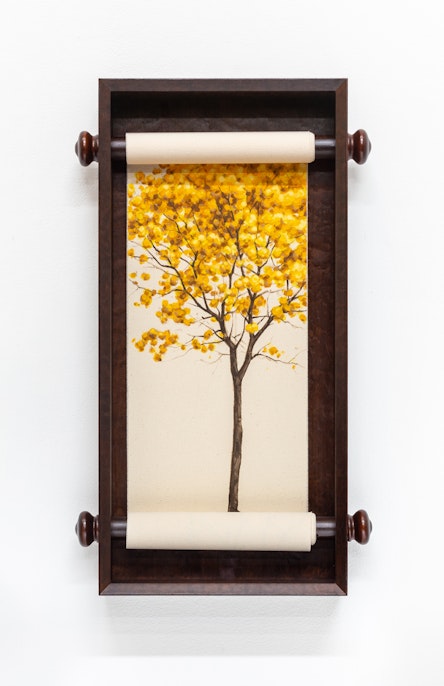
Fabio Baroli (Uberaba, 1981), who is well versed in pictorial language, signs works that are situated on the limits of two-dimensional and three-dimensional formats, following on from the series that formed the basis of his recent solo show Hotspots - Memory, Imagination and Resistance (Zipper, 2021), where large-scale canvases were presented, spreading from the walls to the floor, depicting emblematic trees of the cerrado, one of the most threatened biomes in Brazil due to its central location and the unbridled development of agribusiness in the country's hinterlands. For the fair in Bogotá, Baroli intends to choose symbolic trees from the Colombian Amazon, also at risk due to harmful and irregular economic activities, to represent in small and medium canvases the exuberance of the country's flora. The medium is also close to its object, as they are done on a kind of papyrus, which makes the language of the paintings more ambiguous.

Fabio Baroli (Uberaba, 1981), who is well versed in pictorial language, signs works that are situated on the limits of two-dimensional and three-dimensional formats, following on from the series that formed the basis of his recent solo show Hotspots - Memory, Imagination and Resistance (Zipper, 2021), where large-scale canvases were presented, spreading from the walls to the floor, depicting emblematic trees of the cerrado, one of the most threatened biomes in Brazil due to its central location and the unbridled development of agribusiness in the country's hinterlands. For the fair in Bogotá, Baroli intends to choose symbolic trees from the Colombian Amazon, also at risk due to harmful and irregular economic activities, to represent in small and medium canvases the exuberance of the country's flora. The medium is also close to its object, as they are done on a kind of papyrus, which makes the language of the paintings more ambiguous.
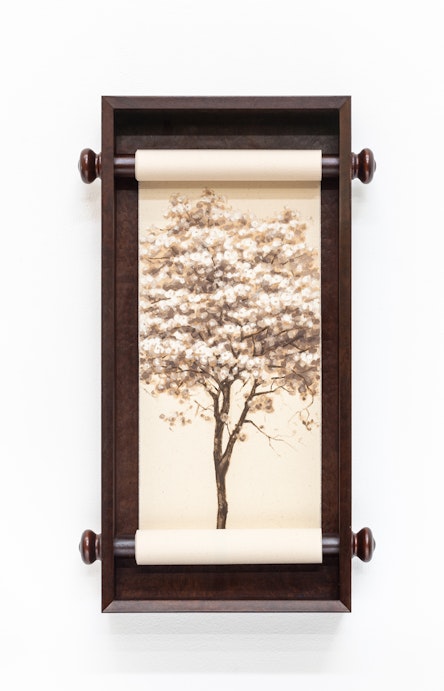
Fabio Baroli (Uberaba, 1981), who is well versed in pictorial language, signs works that are situated on the limits of two-dimensional and three-dimensional formats, following on from the series that formed the basis of his recent solo show Hotspots - Memory, Imagination and Resistance (Zipper, 2021), where large-scale canvases were presented, spreading from the walls to the floor, depicting emblematic trees of the cerrado, one of the most threatened biomes in Brazil due to its central location and the unbridled development of agribusiness in the country's hinterlands. For the fair in Bogotá, Baroli intends to choose symbolic trees from the Colombian Amazon, also at risk due to harmful and irregular economic activities, to represent in small and medium canvases the exuberance of the country's flora. The medium is also close to its object, as they are done on a kind of papyrus, which makes the language of the paintings more ambiguous.
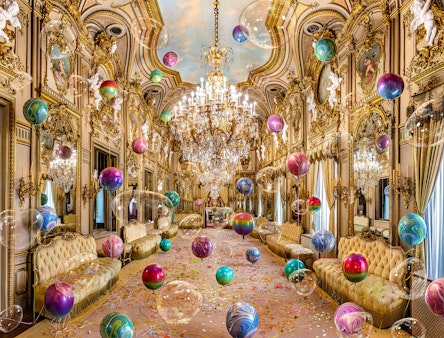
Flávia Junqueira (São Paulo, 1985) uses photography as her primary means of expression. After producing photographs in iconic and diverse sites in Brazil, such as Christ the Redeemer in Rio de Janeiro, the Biennial Pavilion in São Paulo, and the Paz Theatre in Belém and the Amazonas Theatre in Manaus, among other locations, the São Paulo artist intends to use locations in Bogotá, especially theaters of a historical nature. Flávia underlines a certain "carnivalization" of everyday life through the physical insertion of elements that refer to childhood parties, such as balloons, ribbons and streamers, among others into her settings. In these photographic records, therefore, she uses the historical, symbolic and even touristic substrate of the space to develop in it a discord, a subjective disarray that has more to do with a post-party hangover and with the visual simulacra of our era than an effective moment of sharing and communion with the other.
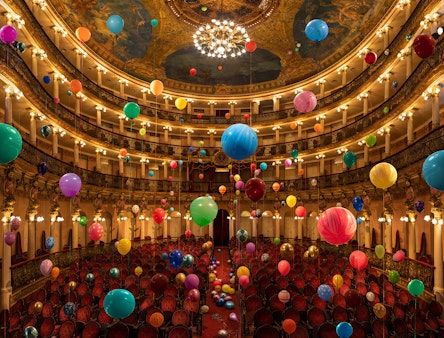
Flávia Junqueira (São Paulo, 1985) uses photography as her primary means of expression. After producing photographs in iconic and diverse sites in Brazil, such as Christ the Redeemer in Rio de Janeiro, the Biennial Pavilion in São Paulo, and the Paz Theatre in Belém and the Amazonas Theatre in Manaus, among other locations, the São Paulo artist intends to use locations in Bogotá, especially theaters of a historical nature. Flávia underlines a certain "carnivalization" of everyday life through the physical insertion of elements that refer to childhood parties, such as balloons, ribbons and streamers, among others into her settings. In these photographic records, therefore, she uses the historical, symbolic and even touristic substrate of the space to develop in it a discord, a subjective disarray that has more to do with a post-party hangover and with the visual simulacra of our era than an effective moment of sharing and communion with the other.
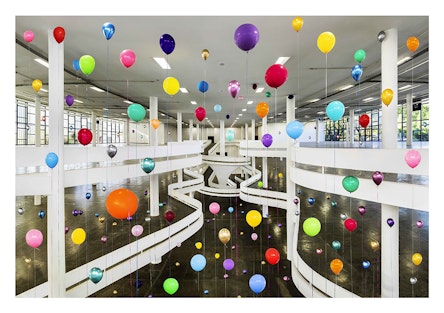
Flávia Junqueira (São Paulo, 1985) uses photography as her primary means of expression. After producing photographs in iconic and diverse sites in Brazil, such as Christ the Redeemer in Rio de Janeiro, the Biennial Pavilion in São Paulo, and the Paz Theatre in Belém and the Amazonas Theatre in Manaus, among other locations, the São Paulo artist intends to use locations in Bogotá, especially theaters of a historical nature. Flávia underlines a certain "carnivalization" of everyday life through the physical insertion of elements that refer to childhood parties, such as balloons, ribbons and streamers, among others into her settings. In these photographic records, therefore, she uses the historical, symbolic and even touristic substrate of the space to develop in it a discord, a subjective disarray that has more to do with a post-party hangover and with the visual simulacra of our era than an effective moment of sharing and communion with the other.
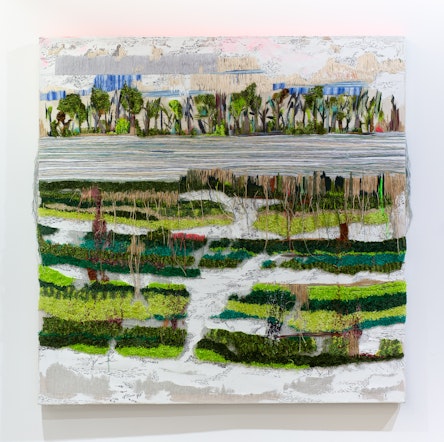
Laura Villarosa (Palermo, Italy, 1961), who exhibits small-scale canvases, sometimes at the intersection of textile art, exploring landscapes between figuration and abstraction. There is often a substrate in her work of situations and places that are emblematic of the varied relationships between the natural and the constructed, such as the works in which she portrays the vigor of rivers, even if rectified, channeled and submerged in the urban fabric of São Paulo. For the Colombian series, Villarosa intends to start from the waterways present in the capital city, both the most preserved ones and those surrendered to degradation, to create her unique panoramas.

Laura Villarosa (Palermo, Italy, 1961), who exhibits small-scale canvases, sometimes at the intersection of textile art, exploring landscapes between figuration and abstraction. There is often a substrate in her work of situations and places that are emblematic of the varied relationships between the natural and the constructed, such as the works in which she portrays the vigor of rivers, even if rectified, channeled and submerged in the urban fabric of São Paulo. For the Colombian series, Villarosa intends to start from the waterways present in the capital city, both the most preserved ones and those surrendered to degradation, to create her unique panoramas.
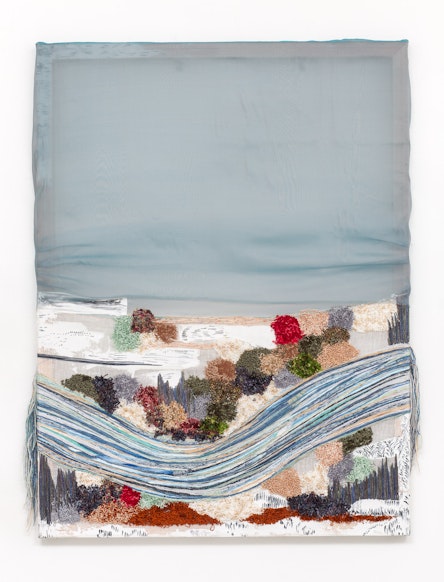
Laura Villarosa (Palermo, Italy, 1961), who exhibits small-scale canvases, sometimes at the intersection of textile art, exploring landscapes between figuration and abstraction. There is often a substrate in her work of situations and places that are emblematic of the varied relationships between the natural and the constructed, such as the works in which she portrays the vigor of rivers, even if rectified, channeled and submerged in the urban fabric of São Paulo. For the Colombian series, Villarosa intends to start from the waterways present in the capital city, both the most preserved ones and those surrendered to degradation, to create her unique panoramas.